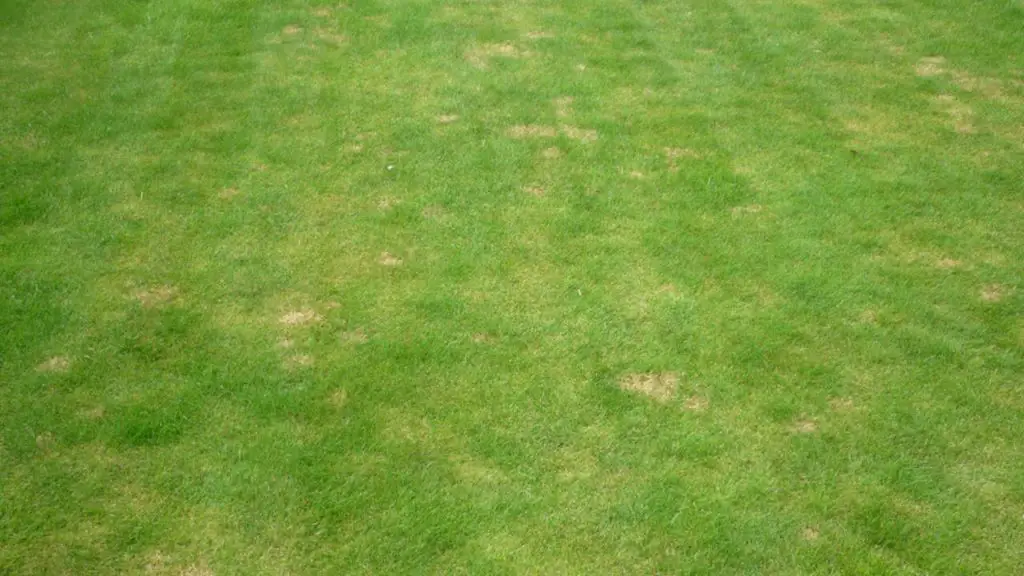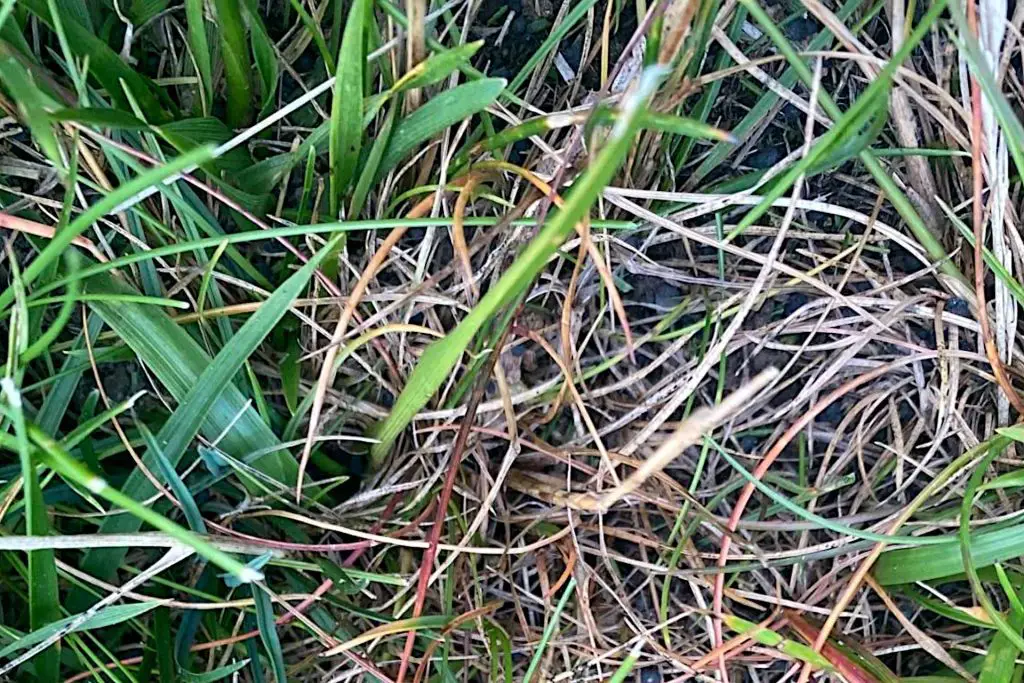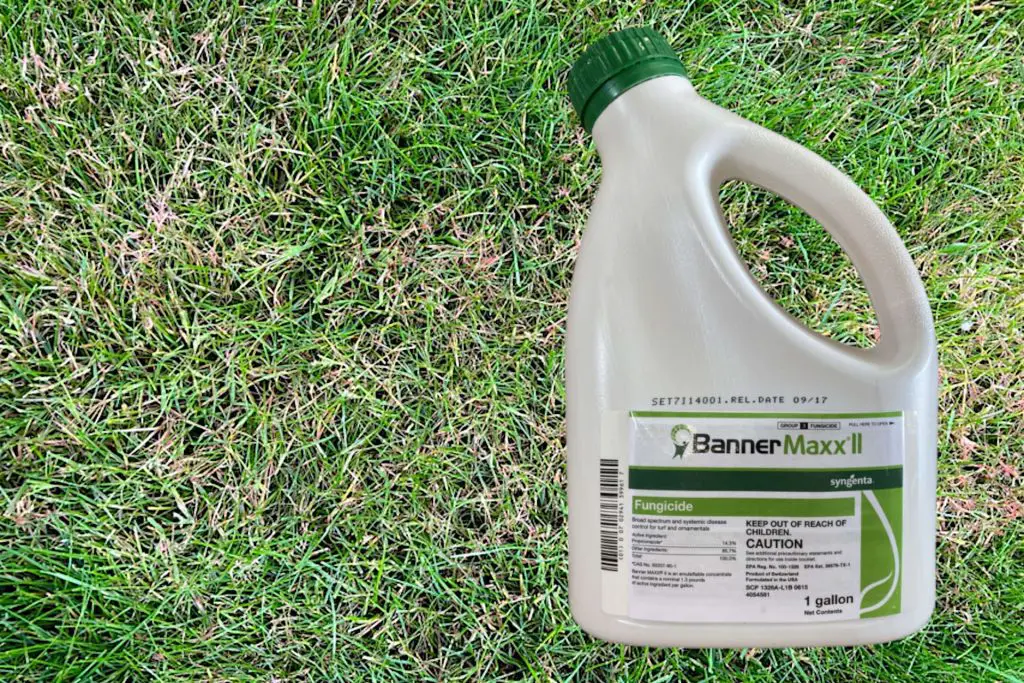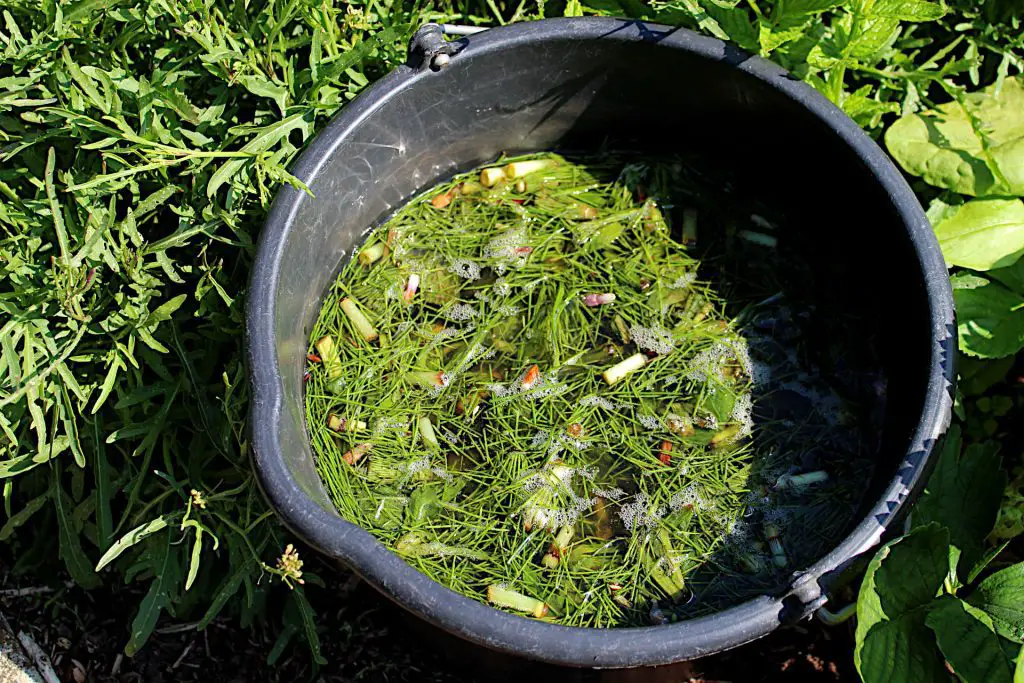Red Thread Grass | Dealing with Red Thread Lawn Disease Through Chemical and Cultural Control
Red Thread Lawn Disease, is a common turfgrass disease that can turn your lush, green lawn into a patchy, discolored mess. If you’ve noticed reddish grass, brown patches on grass, or dead patches of grass, you’re likely dealing with this fungal lawn disease. But worry not! Below we will provide you with advice and solutions for effective lawn care and turfgrass management against Red Thread.
Understanding and treating Red Thread is crucial for maintaining a healthy lawn, especially during wet weather and humid weather conditions. Whether you’re a homeowner looking for home remedies for red thread or a professional seeking advanced fungicide treatments, we’ve got you covered.
We’ll delve into both chemical and cultural control methods, offering a balanced approach to lawn maintenance. From fungicide application to lawn watering and fertilization, you’ll find actionable tips backed by research to help you reclaim your lawn’s health.
Understanding Red Thread Lawn Disease

When it comes to lawn care, one of the most disheartening sights is a once-vibrant lawn marred by patches of discolored grass. Red Thread Lawn Disease, caused by the fungus Laetisaria fuciformis, is a common culprit behind such lawn woes. Having a comprehensive understanding of this turfgrass disease, helps you identify its symptoms, understand its causes, and recognize the environmental factors that contribute to its spread.
What is Red Thread?
Red Thread is a fungal disease that primarily affects grass, turning healthy green blades into a reddish or rusty hue. The disease gets its name from the red or pink thread-like structures that form on the grass blades. These structures are actually the fungal mycelium, which is a clear indicator of the disease.
The first stage is distinguished by the presence of these very thin, red/pink, needle-like strands that protrude from the grass blade. These needle-like strands are called stromata and are able to survive in the soil for up to two years before dying. As soon as they germinate, the stromata attack the grass leaf blades by infecting their stomata.
In the second type stage little, pink cotton wool-like mycelium appears in infected areas which is caused where the glass blades come into contact with each other usually. This can particularly occur in high temperatures and humidity.
Symptoms to Look For:

The earliest indicators of infection in your lawn are little uneven patches of brown or yellow grass that appear randomly over the field. If you look closely, you will be able to see either the small red needles or the second type stage where the pink downy mycelium is visible. Infection grows from tiny patches to huge brown regions, which eventually combine to create vast brown swaths.
- Discolored grass: Ranges from reddish to brown
- Thready grass: Red or pink thread-like structures on the grass
- Weak grass: Grass may appear to be wilting or thinning
Identification and Diagnosis
Correctly identifying Red Thread is the first step toward effective turfgrass management. The disease manifests as brown patches on grass and dead patches on grass, often surrounded by a reddish border.
Seasonal Occurrence:
- Spring Weather: High humidity and mild temperatures create a conducive environment.
- Summer Weather: Less common but can occur during cool, wet summers.
- Fall Weather: Prevalence decreases but can still occur.
- Winter Weather: Least common, as the fungus is less active in cold conditions.
Grass Types Affected:
| Grass Type | Susceptibility |
|---|---|
| Cool-Season Grass | High |
| Warm-Season Grass | Low |
| Shade-Tolerant Grass | Moderate |
| Shade-Intolerant Grass | Low |
Environmental Factors
Understanding the environmental factors that contribute to Red Thread can help in its prevention and control. The disease thrives in specific conditions, often related to weather and climate. In general, this is when temperatures are between 59 and 77 degrees Fahrenheit and when it is rainy. The rate of development of the fungus reduces dramatically when temperatures are beyond 77°F, and it is unable to grow above around 85°F
Weather Conditions:
- Wet Weather: Excessive moisture creates a breeding ground for the fungus.
- Humid Weather: High humidity levels can accelerate the spread.
Nutrient Deficiency:
A lack of essential nutrients can make your lawn more susceptible to diseases. Stressed grass and weakened grass are more prone to Red Thread.
Soil Conditions:
- Overwatering: Leads to waterlogged soil, promoting fungal growth.
- Underwatering: Stresses the grass, making it more susceptible.
Seasonal Variations
The prevalence of Red Thread varies with the seasons, and understanding these patterns can aid in effective lawn maintenance.
- Spring: The disease is most common in late spring when the weather starts to warm up but remains wet.
- Summer: Less common due to higher temperatures but can occur in cool, wet summers.
- Autumn: The disease can linger into the fall, especially during wet, cool conditions.
- Winter: Least common, as the fungus is less active in cold, freezing conditions.
Red Thread Can Easily Spread
The sclerotia, thread-like red webbing structures that support the fungus, are the source of the fungus’ growth and they can spread easily through the air. It is possible for sclerotia to persist for months or years under grass blades if there is strong thatch, or in the soil. The pathogen can be transmitted in various ways but the most common are contact with polluted water, and wind.
In addition, gardening equipment, particularly mowing and other mechanical lawn care processes, can easily transfer the fungus to other areas of the grass. It is therefore important to properly clean your equipment after use. If you employ a lawn care company then you should make sure they do the same.
By understanding the environmental factors and seasonal variations, you can tailor your lawn care practices to mitigate the risk of Red Thread. Whether it’s adjusting your lawn watering schedule or choosing a shade-tolerant grass for a shaded area, small changes can make a big difference.
What damage can Red Thread do to your lawn?
Despite the fact that the grass in the afflicted regions seems to be lifeless, red thread does not kill the grass since the pink growths on the grass do not infect the plant’s crown or roots, and the fungus does not cause the grass to die as a result of its presence. The infected grass is disseminated by the fungus that resides inside it, which spreads via the thatch and soil.
Chemical Control Methods

When it comes to battling Red Thread Lawn Disease, chemical intervention often becomes a necessity. This section will guide you through the labyrinth of chemical control methods, focusing on fungicides that are specifically designed to combat Red Thread and other turfgrass diseases. We’ll explore the types of fungicides available, delve into popular products, and discuss best practices for application, ensuring your lawn care regimen is both effective and safe.1
Introduction to Fungicides
Fungicides play a pivotal role in turfgrass management, especially when dealing with persistent fungal diseases like Red Thread. These chemical agents are designed to either kill the fungus outright or inhibit its growth, thereby protecting your lawn.
Types of Fungicides:
- Contact Fungicides: These act on the surface and are not absorbed by the plant. They are effective for immediate relief but may require frequent reapplication.
- Systemic Fungicides: These are absorbed by the plant and offer longer-lasting protection. They are generally more effective but can be more expensive.
Popular Fungicides for Red Thread Control
When it comes to choosing a fungicide, it’s essential to select one that is specifically designed to combat Red Thread. Below is a table that outlines some popular fungicides, their active ingredients, and other key details.
| Active Ingredient (Class) | Fungicide Class | FRAC Code | Product Name(s) | Diseases Targeted | Mode of Action | Application Method | Resistance Risk |
|---|---|---|---|---|---|---|---|
| Chlorothalonil (Chloronitrile) | Contact | M5 | Daconil, Bravo | Red Thread, Brown Patch | Disrupts cellular processes | Spray | Low |
| Propiconazole (Triazole) | Systemic | 3 | Banner Maxx, Spectator | Red Thread, Dollar Spot | Inhibits ergosterol synthesis | Spray, Granular | Moderate |
| Myclobutanil (Triazole) | Systemic | 3 | Eagle, Systhane | Red Thread, Powdery Mildew | Inhibits ergosterol synthesis | Spray | Moderate |
| Azoxystrobin (Strobilurin) | Systemic | 11 | Heritage, Strobe | Red Thread, Pythium | Inhibits mitochondrial respiration | Spray, Granular | High |
| Thiophanate-Methyl (Benzimidazole) | Systemic | 1 | Cleary’s 3336, Fungo | Red Thread, Fusarium | Inhibits cell division | Spray | High |
| Mancozeb (Dithiocarbamate) | Contact | M3 | Dithane, Manzate | Red Thread, Leaf Spot | Multi-site action | Spray | Low |
Key Points to Consider:
- FRAC Code: This code indicates the risk of developing resistance. Lower numbers often signify a higher risk.
- Application Method: Fungicides can be applied either as a spray or in granular form. The choice often depends on the severity of the disease and your comfort level with the application equipment.
- Resistance Risk: Overuse of fungicides can lead to resistance. Rotating between different types can mitigate this risk.
Best Practices for Fungicide Use
Using fungicides effectively is not just about spraying and forgetting; it requires a well-planned approach. Here are some best practices to ensure the efficacy and safety of your fungicide treatment.
Timing and Weather Conditions:
- Apply fungicides when the grass is dry to ensure maximum absorption.
- Avoid application during windy conditions to prevent drift.
- Consider the weather forecast; rain can wash away the fungicide, reducing its effectiveness.
Safety Measures:
- Always read the label for proper dosage and application methods.
- Wear protective gear, including gloves and a mask, during application.
- Keep pets and children away from the treated area until the fungicide has dried completely.
Environmental Considerations:
- Be mindful of the environmental impact. Some fungicides can be harmful to beneficial insects and aquatic life.
- Opt for eco-friendly or organic options when available.
Fungicide Application Techniques
Proper fungicide application is crucial for effective disease control. Here are some techniques to ensure you get it right:
- Calibration: Make sure your sprayer is calibrated to apply the correct amount.
- Coverage: Ensure even coverage by overlapping spray patterns.
- Post-Application: Water the lawn lightly to help the fungicide penetrate the soil, unless the label advises against it.
Cultural Control Methods (Nonchemical)
While chemical control methods are effective, they are often just a part of a comprehensive lawn care strategy. Cultural control methods focus on creating an environment where Red Thread and other turfgrass diseases are less likely to thrive. From lawn maintenance practices like mowing and watering to lawn renovation techniques, this section will guide you through various ways to manage Red Thread Lawn Disease without relying solely on chemicals.
Lawn Maintenance
Proper lawn maintenance is the cornerstone of a healthy, disease-free lawn. Simple practices can go a long way in preventing Red Thread from taking over your lawn.
Lawn Mowing
- Height: Maintain a consistent mowing height based on the type of grass you have. Too short or too long can stress the grass, making it susceptible to diseases.
- Blade Sharpness: Dull blades can tear the grass, creating openings for fungal diseases.
- Clippings: Leave the clippings on the lawn as they can act as a natural fertilizer, unless the lawn is diseased.
Lawn Watering
- Frequency: Overwatering can create a breeding ground for Red Thread fungus. Water deeply but less frequently.
- Timing: Early morning is the best time for lawn watering as it allows the grass to dry during the day, reducing fungal growth.
Nutrient Management – Lawn Fertilization
One of the key aspects of lawn care to prevent Red Thread is proper nutrient management. A well-fertilized lawn is often less susceptible to diseases.
Lawn fertilization can mitigate the impact of Red Thread by ensuring there is sufficient nitrogen in the soil of the lawn. Indeed it is possible to actually “grow out” the Red Thread infected zone by undertaking an aggressive fertilization program. The fertilizer will aid in the growth of the grass, and then the unhealthy areas of the plant may be mowed away to allow for the growth of younger, healthier blades.
Key Nutrients:
- Nitrogen: Essential for grass growth and color.
- Phosphorus: Important for root development.
- Potassium: Helps in stress resistance.
Fertilization Tips:
- Use a balanced fertilizer that provides all essential nutrients.
- Follow the recommended fertilization schedule for your grass type.
- Use a spreader for even application
- Avoid over-fertilization as it can lead to other lawn problems.
Lawn Renovation and Repair
Sometimes, despite your best efforts, Red Thread can take hold. In such cases, lawn renovation may be necessary.
Lawn Aeration
Improved lawn aeration and drainage of the grass may help lessen the possibility of red thread infesting your lawn.
It is also possible to improve poor drainage and deal with compacted regions by forking or by the use of either solid-tine or hollow-tine dedicated aerators. Scarifying the grass using a lawn rake or an electric scarifier can take away thatch and moss while also increasing the aeration of the turf.
- Why Aerate: Compacted soil can hinder water absorption and root growth. Aeration loosens the soil, improving these aspects.
- When to Aerate: The best time is during the growing season when the grass can heal and fill in the open areas.
Reseeding
- Choosing Grass: Opt for disease-resistant or shade-tolerant grass varieties if your lawn has a history of Red Thread or is mostly shaded.
- Timing: Early fall or spring are the best times for reseeding.
Soil Testing and Amendment
- pH Level: A soil test can reveal the pH level of your soil. Most grasses prefer slightly acidic to neutral soil.
- Nutrient Levels: The test can also indicate any nutrient deficiencies that can be corrected through fertilization.
Seasonal Lawn Care
Your lawn care practices should adapt to the changing seasons to ensure year-round health.
Spring
- Fertilization: A light application of a balanced fertilizer can kickstart grass growth.
- Watering: As temperatures rise, adjust your watering schedule to ensure the grass receives adequate moisture.
Summer
- Mowing: Raise the mowing height to help the grass retain moisture.
- Watering: Early morning watering is crucial to combat the heat.
Autumn
- Aeration and Reseeding: This is the perfect time for these lawn renovation activities.
- Fertilization: A high-potassium fertilizer can prepare the grass for winter.
Winter
- Mowing: Lower the mowing height for the last cut of the season.
- Clean-Up: Remove any debris like leaves and twigs that can harbor fungi.
Natural and Home Remedies

While chemical control methods are effective, they may not always align with your environmental concerns or personal preferences. That’s where natural and home remedies come into play. These alternatives offer a more eco-friendly approach to combating Red Thread Lawn Disease and maintaining overall lawn health.
Organic Fungicides
Believe it or not, there are organic options when it comes to fungicides. These are derived from natural sources and are less harmful to the environment.
- Neem Oil: This natural oil has fungicidal properties and can be effective against Red Thread when applied regularly.
- Baking Soda Spray: A mixture of baking soda and water can act as a mild fungicide and may offer some relief from Red Thread fungus.
Compost Tea
Compost tea is a nutrient-rich liquid made from steeping compost in water. It can act as a soil conditioner and may help in disease prevention.
- How to Make: Steep compost in water for 24-48 hours, stirring occasionally.
- Application: Spray the tea directly onto the grass or use it as a soil drench.
Cultural Practices
As discussed in the previous section, cultural control methods like proper lawn mowing and lawn watering can go a long way in disease prevention. These practices are natural remedies in their own right.
- Mowing: Keep your mower blades sharp to avoid tearing the grass, which can make it susceptible to Red Thread.
- Watering: Early morning is the best time to water your lawn, as it allows the grass to dry during the day, reducing the risk of fungal growth.
Household Items
Some common household items can also serve as natural remedies for Red Thread.
- Milk Spray: A diluted milk spray can act as a mild fungicide.
- Garlic Extract: Garlic has natural antifungal properties and can be used as a soil drench.
By incorporating these natural and home remedies into your lawn care routine, you can manage Red Thread Lawn Disease without resorting to chemicals. These methods are not only effective but also kinder to the environment, making them a win-win solution for sustainable lawn maintenance.
Prevention and Future Management
The adage “prevention is better than cure” holds true when dealing with Red Thread Lawn Disease. While treating an infected lawn is essential, taking steps to prevent future outbreaks is equally crucial. This section will guide you through various prevention and future management strategies to keep Red Thread at bay.
Lawn Monitoring
Regularly inspect your lawn for early signs of Red Thread or any other turfgrass disease. Early diagnosis can make treatment more effective.
- Visual Checks: Look for discolored grass, brown patches, or thready grass.
- Soil Tests: Conduct periodic soil tests to check for nutrient imbalances that could make your lawn susceptible to diseases.
Seasonal Care
Each season brings its own set of challenges and opportunities for lawn care. Tailoring your maintenance practices to the season can help in disease prevention.
- Spring: Apply a balanced fertilizer and adjust your watering schedule.
- Summer: Raise the mowing height to help the grass retain moisture.
- Autumn: This is the ideal time for lawn aeration and reseeding.
- Winter: Keep the lawn clean to prevent any fungal growth.
Nutrient Management
Proper fertilization is key to a healthy, disease-resistant lawn. Use a balanced fertilizer that provides all essential nutrients, and follow the manufacturer’s guidelines for application rates and timing.
Resistance Planning
If your lawn has a history of Red Thread, consider planting disease-resistant grass varieties. Consult local turfgrass management experts for recommendations tailored to your region and climate.
Environmental Considerations
Be mindful of your lawn’s environmental impact. Opt for eco-friendly fertilizers and pesticides whenever possible, and consider integrating natural remedies into your lawn care routine.
By adopting these prevention and future management strategies, you can significantly reduce the risk of Red Thread Lawn Disease reoccurring in your lawn. Remember, a proactive approach is often the most effective way to ensure long-term lawn health and beauty.
Final Thoughts
As we wrap up this comprehensive guide on Red Thread Lawn Disease, it’s clear that managing this common turfgrass disease is not a one-size-fits-all endeavor. From chemical control methods to cultural practices and natural remedies, there are multiple avenues to explore when it comes to effective lawn care and disease management.
The key takeaway is that prevention is your first line of defense. Regular lawn monitoring, seasonal lawn maintenance, and proper nutrient management can go a long way in keeping Red Thread and other lawn diseases at bay. If prevention fails, early diagnosis and treatment are crucial for minimizing damage and restoring your lawn to its former glory.
It’s also worth noting that while chemical treatments like fungicides are effective, they should be used responsibly. Overreliance on chemicals can lead to resistance and have a negative environmental impact. Therefore, consider incorporating natural and home remedies as part of a balanced lawn care strategy.
Lastly, don’t underestimate the power of knowledge. Stay informed about the latest best practices, research, and treatment options available for Red Thread Lawn Disease. Consult with turfgrass management experts, and don’t hesitate to seek professional help if the situation calls for it.
In summary, Red Thread Lawn Disease is manageable, and with the right approach, you can maintain a lush, green lawn that’s the envy of the neighborhood. Whether you’re a seasoned gardener or a lawn care newbie, this guide has equipped you with the tools and knowledge you need to tackle Red Thread head-on. Here’s to a healthy, beautiful lawn!
Videos
References
- University of Missouri: Red Thread Lawn Disease
